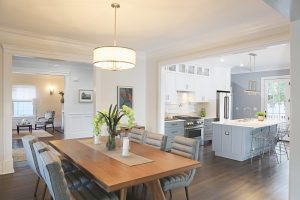How to paint your home without a professional?

Are you thinking of painting the house yourself and feeling stressed? So learn that with the right tips and ideas, painting your home can become easy, fun and completely refreshing!
Painting the house inside or outside is something highly creative and refreshing. With the right instructions, using your imagination, personal taste and the style that suits your space, you can easily paint your house inside or outside and have an impressive result that you will enjoy for a long time!
Without proper wall preparation, the wall paint will never be perfect. A series of simple steps for a perfect result.
The preparation of the wall
We cover the floor with the protective plastic film and stabilize it.
After cutting off the electricity, disassemble the switches and sockets.
If it is an already painted wall, we have to wash it completely. It is a very important process especially if the area we are working in is the kitchen.
After it dries, we sand the wall with 80/100 sandpaper to smooth the surface.
On a wall covered with wallpaper, after removing the wallpaper, smooth the surface using 80-grit sandpaper so that every last trace of glue is removed.
We must apply a primer to plasterboards.
In the event that the wall has cracks and holes, we must first putty them.
Smoothing a wall in good condition
To prepare putty powder, first put the water in a small basin and then pour the powder evenly.
Mix until you have a homogeneous mixture that remains stuck to the spatula without dripping.
We apply the putty working from right to left or vice versa, in case we are left-handed.
We spread the product in strips that overlap slightly, starting from the corner of the wall and continuing from top to bottom.
For more comfort, we first cover a surface of one square meter and then go down to the next lane.
When we reach the skirting board, we work from the bottom up to reconnect with where we came from.
Where the wide spatula does not fit, we use a narrower spatula.
for the corners of the wall we use a special spatula for corners.
Let the product dry for the time indicated on its packaging before smoothing the wall. We use fine sandpaper to smooth the surface or an electric sander.
Without waiting, we smooth the surface of the putty with the sander.
We proceed in parallel strips, as in the classic application, but we avoid too much pressure with the sander: we must not scrape but smooth to level.
When the putty dries, dust the surface with a brush, then go over it again with a wet sponge that should be rinsed often.
Smoothing out a wall in bad shape
In the event that we have removed plasterboard wallpaper, it is possible that the paper coating has worn away in some places.
We spread a thicker layer of putty to fill all the defects: then we proceed with the smoothing keeping the spatula tilted towards the wall.
Before we start painting, we dust the surface with a brush, then go over it again with a wet sponge that we should rinse often.
Based on the result, we decide whether or not to apply a second coat of putty.
Smooth and leveled, the walls are ready to be painted in the desired color.
What kind of colors to choose?
According to the needs of your home, you can choose from the popular interior plastics, acrylics, watercolors to elastomeric paints (with insulating properties), silicone-based, anti-mould, heat-insulating and fire-resistant wall paints.
For a first approach, you must first take into account the characteristics of the surface to be painted. They don’t make all kinds of colors for all rooms in the house. This is due to the different moisture levels in each of them.
Plastic colors
Quite popular in wall paints are plastics with their main characteristics, high coverage, good spreading and quick drying, while they can be ecological at the same time. Plastic paints are suitable for interior surfaces.
Acrylic colours
Acrylic paints are suitable for outdoor spaces, as they contain acrylic resins that make them ideal for areas with humidity and extreme weather conditions (mountain, sea), since they combine the waterproofing of the surface and its simultaneous breathability.
Watercolors
The watercolor for indoor painting is suitable for stairwells or indoor ceilings, as it has the ability to leave the pores of the surface open, allowing the space to breathe, absorbing moisture. It combines great whiteness with high coverage, easy application and very good drying.






